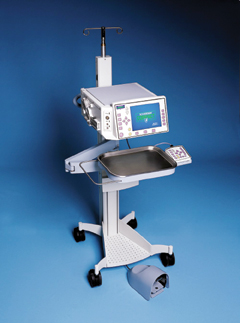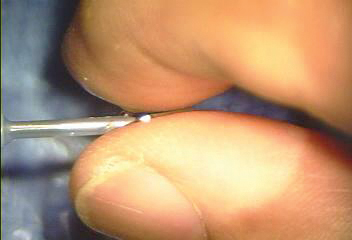Leading-edge phacoemulsification technology allows surgeons more control in the procedure than they've ever had before. Followability is increased, and some of the known hazards of phaco, especially thermal injury to the eye, are reduced. Further modulation of ultrasound energy, or the availability of altogether different sources of power, are to be credited for safer, more efficient procedures. This article reviews the innovations of three of the next-generation phaco machines available in the U.S. market: Alcon's Infiniti Vision System, the Sovereign with WhiteStar from Advanced Medical Optics and Staar Surgical's SonicWave.
Infiniti Vision System
Alcon's latest offering is the Infiniti Vision System, introduced to the U.S. market in April 2003. Three energy delivery modes are available: ultrasound, NeoSoniX and AquaLase (a component available commercially only since September 2003). By using any of these modes with the rede-signed fluidic management system, Alcon says a surgeon should be able to remove any grade cataract.
While modulation of ultrasound power via pulse and burst modes has been available for some years, the Infiniti takes it a step further with variable "hyper" pulse. Instead of having a fixed duty cycle at 50 percent of energy, the surgeon can now select the "on" time. The "off" time is then dictated by the software, explains Kevin Creed, global group product director—cataract instrumentation for Alcon.
 |
| Alcon's Infiniti Vision System offers NeoSoniX and AquaLase in addition to ultrasound mode to handle any grade of cataract. |
"With hyper pulse and burst modes, the Infiniti can achieve mere milliseconds of ultrasound time per burst," says Robert J. Cionni, MD, of the Cincinnati Eye Institute. "With burst, both burst rate and power can be linearly controlled, further improving efficiency and safety."
The addition of a handpiece with an oscillating tip puts the NeoSoniX mode ahead of traditional ultrasound. "NeoSoniX can be utilized with continuous, pulse, hyper pulse or burst to in-crease followability and thereby decrease ultrasound time and power usage even further," says Dr. Cionni.
Enhanced followability is a plus of NeoSoniX, notes Mr. Creed. "The side-to-side movement constantly re-positions nucleus on the tip, making it easier to maintain occlusion and im-proving followability," he explains. "The oscillations only operate at
100 Hz and therefore do not generate any appreciable heat." NeoSoniX might be the right choice for a dense cataract or one where keeping the nuclear fragments at the tip is important.
"The idea behind AquaLase is to make phaco a safer procedure," says Mr. Creed. Since a liquid jet performs the emulsification, "there's absolutely no incisional heat and no friction, because the tip doesn't vibrate. Plus, with the tip being soft and round as opposed to sharp and metal, it's friendlier to the posterior capsule," he adds.
Robert Lehmann, MD, of Nacogdoches, Texas, an early adopter of AquaLase, thinks the liquid energy source will afford surgeons increased comfort in working in the capsular bag.
While AquaLase is intended to be used on cataracts of grade 3 or less, Dr. Lehmann believes it will come into its own as interest in refractive lens ex-change increases, since it will be "capsule-friendly" in RLE cases.
Any of the Infiniti's energy-delivery modes would be unable to reach its potential without the machine's fluidic management system, says Mr. Creed. He explains that the fluidics hardware is completely noncompliant. Lisa Bro-thers Arbisser, MD, of Eye Surgeons Associates, P.C., in Illinois, describes the Infiniti's fluidics as "enhanced beyond any we have seen before." She says she uses far less irrigation in her cases, which translates into better en-dothelial cell health.
If a surgeon wants to take full advantage of the Infiniti's capabilities, Cin-cinnati's Dr. Cionni stresses the need to take the time to understand the dif-
ferent modes. "I typically use Aqua-Lase in cataract grades 2+ NSC or less, linear burst ultrasound for grades 3 and 4, and I add NeoSoniX for brunescent lenses," he reveals. His technique remains much the same for all cases. "I sculpt a groove at low vacuum, divide the nucleus, and then increase vacuum to chop and remove the quadrants. The only exception is AquaLase, where the magnitude (power) has to be carefully titrated to vacuum and flow to prevent chatter."
Dr. Cionni appreciates the ability to switch between modes simply and quickly, because, he says, this "allows the surgeon to use the most efficient, safest technique for each case."
Sovereign System with WhiteStar
AMO added WhiteStar technology to its Sovereign System in 2003 to further modulate the amount of energy introduced into the eye during surgery while maintaining full ultrasound cutting efficiency. "For several years, all of the different phaco platforms have had the ability to deliver ultrasound power in pulse or burst mode, where a duty cycle modulates the power every few seconds," says Becky Cope, U.S. marketing manager—Sovereign System. "What WhiteStar does differently is that it introduces millisecond pulses. Instead of delivering 20 pulses per second, it delivers that power in five milliseconds."
 |
| Advanced Medical Optics designed the Sovereign Compact with WhiteStar technology to meet a specific market need: surgery suites with space and/or budget constraints and/or rotating staff. The Sovereign Compact offers all of the innovation of the flagship machine, but is repackaged with with only the key capabilities in a smaller footprint. |
Ms. Cope adds that the on/off times of the duty cycles are individually variable. "In previous technologies, including ours, there was a standard 'on' time that equated to a standard 'off' time: on for 20, off for 20. WhiteStar's large range of preset duty cycles allows the surgeon to have power on for five milliseconds, but then off for 10, for example," she explains. The energy introduced into the eye should be allowed time to disperse before a new pulse is introduced, says Ms. Cope, to reduce or eliminate heating.
"We also found that full energy dissipation before introduction of another pulse has some effects on followability; it's easier to regrasp the cataract material," she says.
As with all of the machines reviewed in this article, a surgeon may find it necessary to switch back to continuous ultrasound mode for the brunescent cataract. "If the cataract is really dense, you may find it takes you longer to get the cataract out with WhiteStar," notes Dr. Weinstock. "The benefit is that you can use it for some cases, and go back to the standard settings for others."
"Every surgeon might use WhiteStar differently, but no one should have to change his phaco technique to use the Sovereign. In fact, I recommend not changing anything you normally do. Then change one thing at a time once you learn the machine's settings," advises Dr. Weinstock.
SonicWave Phaco System
Staar Surgical considers its SonicWave to have been the first market-ready alternative to ultrasound, given that it was introduced into the U.S. market in 2000. While the SonicWave can be used in continuous or pulsed ultrasound mode, its innovation is in the availability of sonic energy, at a frequency much lower (40 – 400 Hz) than that of ultrasound (40,000 Hz). For this reason, Harry B. Grabow, MD, of the Sarasota Cataract & Laser Institute in Florida, calls the SonicWave the "true" cold phaco machine. "By reducing the frequency down to possibly 1/1000th of what it can be with ultrasound, we are delivering only 1/1000th of that energy into the eye, greatly reducing the po-tential for damage to the endothelium," Dr. Grabow says. "And, by reducing the frequency to that level," he adds, "the followability that surgeons are looking for greatly increases. The repulsive force of ultrasound is not there."
According to Dave Van Voorhis, a phaco specialist at Staar, the "hyposonic" energy delivered by the SonicWave enhances safety. "Ultrasound is so powerful that it can buzz right through the capsule, the iris, the zonules or anything else," says Mr. Van Voorhis. "The sonic frequency offers the surgeon a margin of safety. Rather than plowing right through, the sonics will allow the ocular tissue to vibrate a bit, at the same frequency as the tip. The surgeon's got a moment to back off the pedal."
 |
| A surgeon touches the live tip of the SonicWave handpiece to illustrate the "coolness" of sonic frequencies. Photo: I. Howard Fine, MD and Staar Surgical. |
It follows that a cool sonic energy that is gentler on the ocular tissues may not offer the same coring power as traditional ultrasound. Staar's response is that the perceived loss of power can be augmented by stronger fluidics. "Advanced fluidics provide higher vacuum levels and stronger aspiration flow rates.
Without the 'power' of ultrasound, the SonicWave's fluidics help get the job done without being in there all day," says Mr. Van Voorhis. Staar's engineers created PeriVent fluidics, a combination of peristaltic and venturi pump styles. Mr. Van Voorhis says PeriVent offers the best of both systems and works well in I/A, phaco, and other modes.
"I find the fluidics on the SonicWave to be very responsive," nods Dr. Gra-bow. "When I touch the pedal it goes, and when I let off, it stops. This responsiveness is necessary when you have a lower frequency source of energy in order to get efficient removal of cataract material."
"We've never taken ultrasound capability away from the SonicWave," says Mr. Van Voorhis. "We've given the physicians a kick switch where they can start out in traditional ultrasound, but when they've done the nucleus and want to do the epinucleus and cortex, they can go into sonic energy. How and if they blend it depends on the user. A surgeon's got the ability to go to
500 mmHg of vacuum in ultrasound and sonic and 50 cc of flow as the max. In I/A, he can go to 600 mmHg."
Dr. Grabow notes that sonics is more efficient in certain types of cataracts. "It is terrific for me to see the improved attractability and holdability when I am in sonic. The sonic energy works for me in up to some 3+ nuclear cataracts.
| Microincision Cataract Surgery — One Step Closer |
| Microincision surgery to remove a cataract or prepare for refractive lens exchange is poised to take lens extraction to the next level, says Robert Weinstock, MD. Even among those who don't believe that microincision surgery has added value at the present time, there is some agreement on what is needed to get to the point where microincision surgery would be the across-the-board preferred technique for cataract removal. One component is an intraocular lens that could be put through a sub 2-mm incision. Enlarging a small phaco incision to insert a larger lens isn't optimal for some surgeons who prefer to wait for the lens's arrival. The other necessary piece of the puzzle is a phaco machine that works with less heat and can be paired with an unsleeved phaco tip. While surgeons in most of the world are still waiting on the sub 2-mm IOL, the phaco machines are here today, says AMO's Becky Cope. "We've got the power modulation available for sleeveless phaco to be done safely and effectively," she says. —H.W. |
Dr. Grabow reports that he has been using this technique with the SonicWave successfully for years. "A few days and several cases will show you how the low frequency can work for you."



